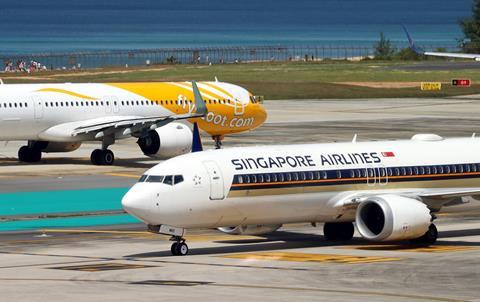Singapore Airlines Group reported a significant drop in its half-year profit – from the previous year’s record high – as it flags a “moderation” in passenger yields from “strong” competition.
Passenger traffic growth at the group also fell short of the capacity added, resulting in a dip in passenger load factors.

For the six months ended 30 September, the group – comprising network carrier SIA and low-cost unit Scoot – recorded an operating profit of S$796 million ($602 million). That is down nearly 49% year on year. Net profit was similarly down to S$742 million in the first half.
Group revenue rose 3.7% to S$9.5 billion, with passenger and cargo turnover both increasing. However, SIA says “increased competition and higher passenger capacity in key markets” impacted passenger yields, which fell 5.6%. Cargo yields also dropped 13.4% as bellyhold capacity recovered.
The group’s two airlines lifted passenger numbers almost 11% to 19.2 million during the first half. However, traffic growth of 7.9% failed to keep pace with the group’s 11% increase in capacity.
SIA Group reported a 14% rise in costs, driven mainly by its net fuel costs rising almost a fifth.
It adds: “Despite the impact of general price inflation, the group kept the rise in non-fuel costs to be largely in line with the 10.6% growth in overall capacity, thanks to its operational efficiency initiatives.”
It expects travel demand to continue to be “robust” for the second half of the financial year, which ends 31 March 2025. However, it warns that its operating environment will continue to be competitive.
SIA had previously flagged a weakening of yields – despite a healthy demand outlook – as other airlines in Asia-Pacific ramp up capacity.
“As the aviation industry grapples with geo-political tensions, macroeconomic uncertainty, increased competition, and inflationary cost pressures, the group remains well-positioned to navigate these from a position of strength,” it states.





















![Cathay Pacific X Air New Zealand[2][3][3][4][1]](https://d3lcr32v2pp4l1.cloudfront.net/Pictures/100x67/1/2/5/106125_cathaypacificxairnewzealand23341_78878.jpg)




